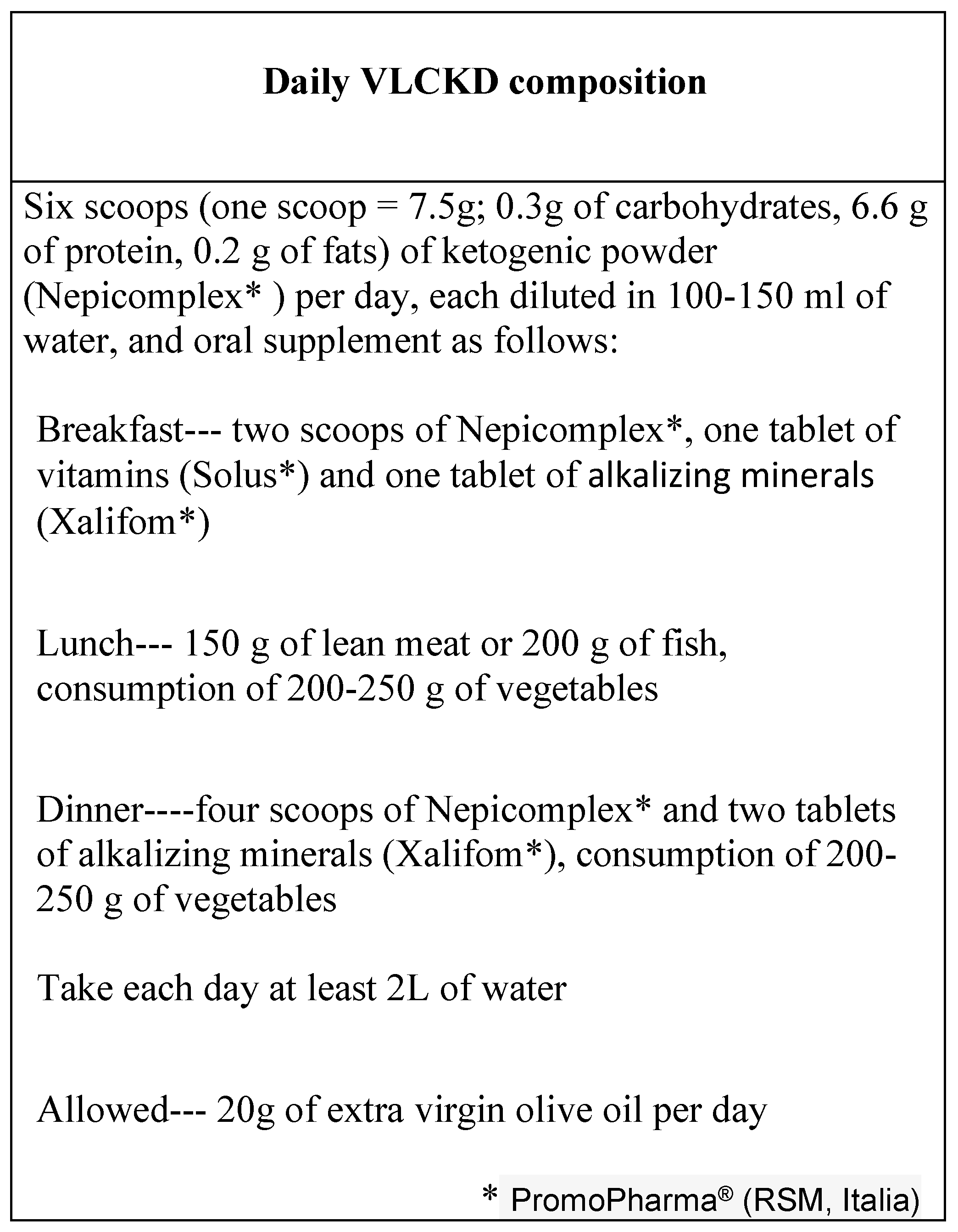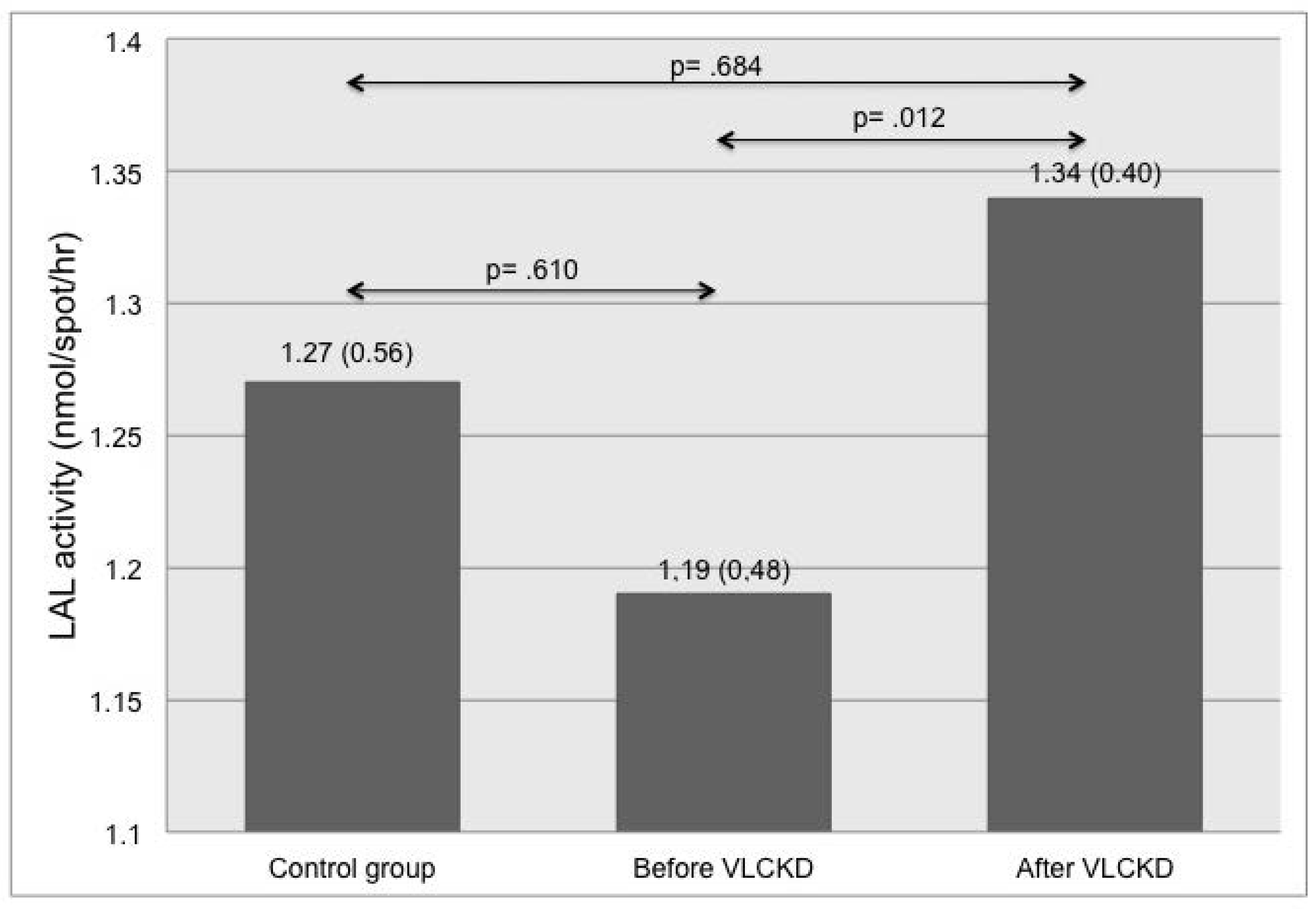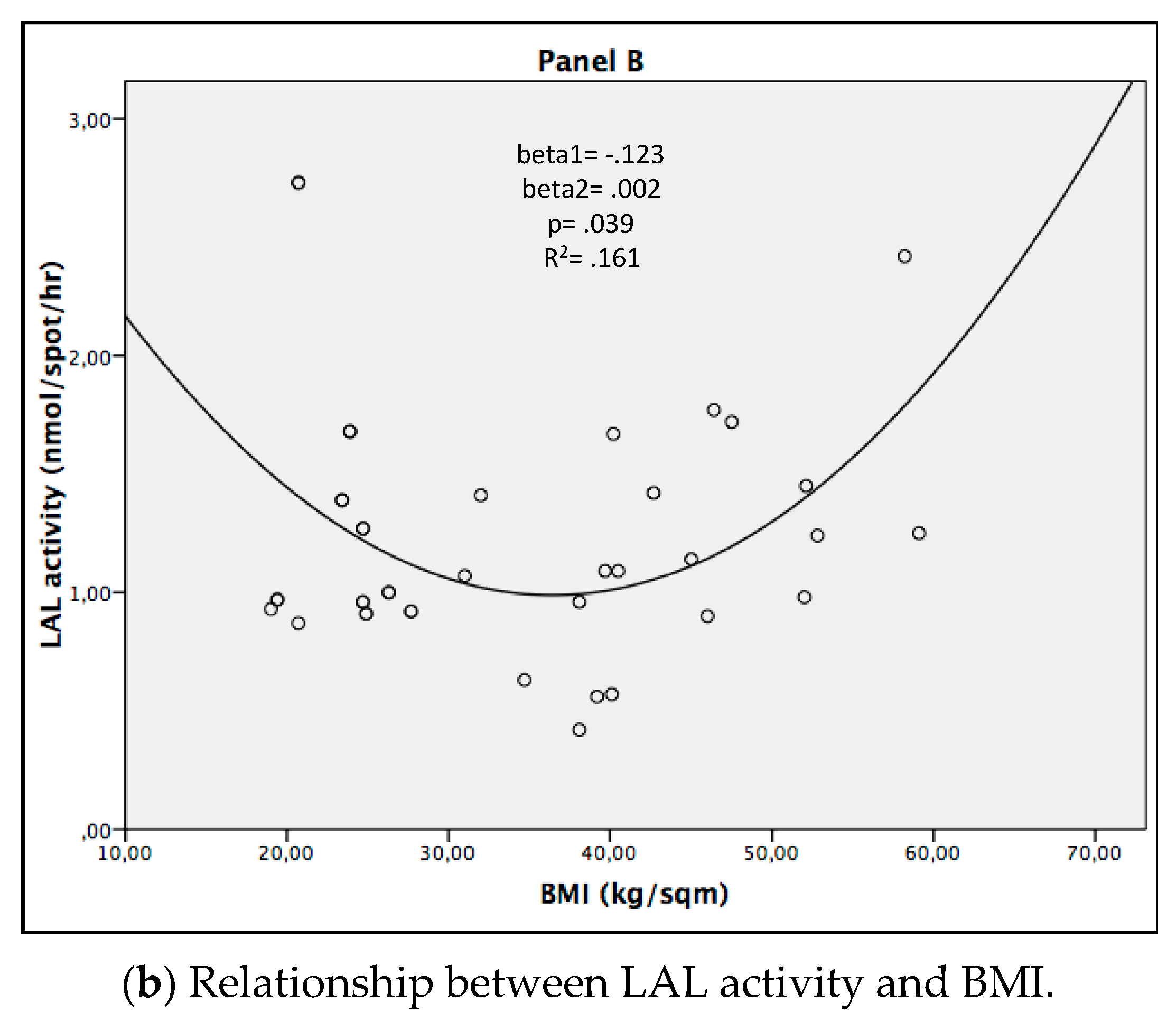Lysosomal Acid Lipase as a Molecular Target of the Very Low Carbohydrate Ketogenic Diet in Morbidly Obese Patients: The Potential Effects on Liver Steatosis and Cardiovascular Risk Factors
Abstract
1. Introduction
2. Experimental Section
2.1. Study Population
2.2. Diet Composition
2.3. Serum Measurement of Biochemical Markers
2.4. Lysosomal Acid Lipase Activity Assay
2.5. Bioimpedentiometry
2.6. Ultrasonography
2.7. Statistical Analysis
3. Results
4. Discussion
5. Conclusions
Author Contributions
Funding
Conflicts of Interest
References
- Vernon, G.; Baranova, A.; Younossi, Z.M. Systematic review: The epidemiology and natural history of non-alcoholic fatty liver disease and non-alcoholic steatohepatitis in adults. Aliment. Pharmacol. Ther. 2011, 34, 274–285. [Google Scholar] [CrossRef]
- van Wissen, J.; Bakker, N.; Doodeman, H.J.; Jansma, E.P.; Bonjer, H.J.; Houdijk, A.P. Preoperative Methods to Reduce Liver Volume in Bariatric Surgery: A Systematic Review. Obes. Surg. 2016, 26, 251–256. [Google Scholar] [CrossRef]
- Moreno, B.; Bellido, D.; Sajoux, I.; Goday, A.; Saavedra, D.; Crujeiras, A.B.; Casanueva, F.F. Comparison of a very low calorie ketogenic diet with a standard low-calorie diet in the treatment of obesity. Endocrine 2014, 47, 793–805. [Google Scholar] [CrossRef]
- Wycherley, T.P.; Thompson, C.H.; Buckley, J.D.; Luscombe-Marsh, N.D.; Noakes, M.; Wittert, G.A.; Brinkworth, G.D. Long-term effects of weight loss with a very-low carbohydrate, low saturated fat diet on flow mediated dilatation in patients with type 2 diabetes: A randomised controlled trial. Atherosclerosis 2016, 252, 28–31. [Google Scholar] [CrossRef] [PubMed]
- Yancy, W.S., Jr.; Foy, M.; Chalecki, A.M.; Vernon, M.C.; Westman, E.C. A low-carbohydrate ketogenic diet to treat type 2 diabetes. Nutr. Metab. 2005, 2, 34. [Google Scholar] [CrossRef] [PubMed]
- Hu, T.; Mills, K.T.; Yao, L.; Demanelis, K.; Eloustaz, M.; Yancy, W.S., Jr.; Kelly, T.N.; He, J.; Bazzano, L.A. Effects of low-carbohydrate diets versus low-fat diets on metabolic risks factors: A meta-analysis of randomized controlled clinical trials. Am. J. Epidemiol. 2012, 176 (Suppl. 7), S44–S54. [Google Scholar] [CrossRef]
- Lin, W.Y.; Wu, C.H.; Chu, N.F.; Chang, C.J. Efficacy and safety of very-low-calorie diet in Taiwanese: A multicenter randomized, controlled trial. Nutrition 2009, 25, 1129–1136. [Google Scholar] [CrossRef]
- Mohler, E.R., 3rd; Sibley, A.A.; Stein, R.; Davila-Roman, V.; Wyatt, H.; Badellino, K.; Rader, D.J.; Klein, S.; Foster, G.D. Endothelial function and weight loss: Comparison of low-carbohydrate and low-fat diets. Obesity 2013, 21, 504–509. [Google Scholar] [CrossRef]
- Raitakari, M.; Ilvonen, T.; Ahotupa, M.; Lehtimäki, T.; Harmoinen, A.; Suominen, P.; Elo, J.; Hartiala, J.; Raitakari, O.T. Weight reduction with very-low-caloric diet and endothelial function in overweight adults: Role of plasma glucose. Arterioscler. Thromb. Vasc. Biol. 2004, 24, 124–128. [Google Scholar] [CrossRef] [PubMed]
- Schwingshackl, L.; Hoffmann, G. Low-carbohydrate diets impair flow-mediated dilatation: Evidence from a systematic review and meta-analysis. Br. J. Nutr. 2013, 110, 969–970. [Google Scholar] [CrossRef]
- Leonetti, F.; Campanile, F.C.; Coccia, F.; Capoccia, D.; Alessandroni, L.; Puzziello, A.; Coluzzi, I.; Silecchia, G. Very low-carbohydrate ketogenic diet before bariatric surgery: Prospective evaluation of a sequential diet. Obes. Surg. 2015, 25, 64–71. [Google Scholar] [CrossRef] [PubMed]
- Popov, V.B.; Lim, J.K. Treatment of non-alcoholic fatty liver disease: The role of medical, surgical and endoscopic weight loss. J. Clin. Transl. Hepatol. 2015, 3, 230–238. [Google Scholar] [PubMed]
- Pilone, V.; Tramontano, S.; Renzulli, M.; Romano, M.; Cobellis, L.; Berselli, T.; Schiavo, L. Metabolic effects, safety, and acceptability of very low-calorie ketogenic dietetic scheme on candidates for bariatric surgery. Surg. Obes. Relat. Dis. 2018, 14, 1013–1019. [Google Scholar] [CrossRef] [PubMed]
- Hoffman, E.P.; Barr, M.L.; Giovanni, M.A.; Murray, M.F. Lysosomal Acid Lipase Deficiency. In Gene Reviews®; Adam, M.P., Ardinger, H.H., Pagon, R.A., Wallace, S.E., Bean, L.J.H., Stephens, K., Amemiya, A., Eds.; University of Washington: Seattle, WA, USA, 1993–2019. [Google Scholar]
- Muntoni, S.; Wiebusch, H.; Jansen-Rust, M.; Rust, S.; Schulte, H.; Berger, K.; Pisciotta, L.; Bertolini, S.; Funke, H.; Seedorf, U.; et al. Heterozygosity for lysosomal acid lipase E8SJM mutation and serum lipid concentrations. Nutr. Metab. Cardiovasc. Dis. 2013, 23, 732–736. [Google Scholar] [CrossRef]
- Bernstein, D.L.; Hülkova, H.; Bialer, M.G.; Desnick, R.J. Cholesteryl ester storage disease: Review of the findings in 135 reported patients with an underdiagnosed disease. J. Hepatol. 2013, 58, 1230–1243. [Google Scholar] [CrossRef] [PubMed]
- Baratta, F.; Pastori, D.; Del Ben, M.; Polimeni, L.; Labbadia, G.; Di Santo, S.; Piemonte, F.; Tozzi, G.; Violi, F.; Angelico, F. Reduced lysosomal acid lipase activity in adult patients with non-alcoholic fatty liver disease. EBioMedicine 2015, 2, 750–754. [Google Scholar] [CrossRef] [PubMed]
- Tovoli, F.; Napoli, L.; Negrini, G.; D’Addato, S.; Tozzi, G.; D’Amico, J.; Piscaglia, F.; Bolondi, L. A relative deficiency of lysosomal acid lypase activity characterizes non-alcoholic fatty liver disease. Int. J. Mol. Sci. 2017, 18, 1134. [Google Scholar] [CrossRef]
- Nahler, G. Lorentz-formula. In Dictionary of Pharmaceutical Medicine; Springer: Wien, Austria, 2009. [Google Scholar]
- Beechy, L.; Galpern, J.; Petrone, A.; Das, S.K. Assessment tools in obesity—Psychological measures, diet, activity, and body composition. Physiol. Behav. 2012, 107, 154–171. [Google Scholar] [CrossRef]
- Hamilton, J.; Jones, I.; Srivastava, R.; Galloway, P. A new method for the measurement of lysosomal acid lipase in dried blood spots using the inhibitor Lalistat 2. Clin. Chim. Acta 2012, 413, 1207–1210. [Google Scholar] [CrossRef]
- Cengiz, M.; Sentürk, S.; Cetin, B.; Bayrak, A.H.; Bilek, S.U. Sonographic assessment of fatty liver: Intraobserver and interobserver variability. Int. J. Clin. Exp. Med. 2014, 7, 5453–5460. [Google Scholar]
- Stolk, R.P.; Wink, O.; Zelissen, P.M.; Meijer, R.; van Gils, A.P.; Grobbee, D.E. Validity and reproducibility of ultrasonography for the measurement of intra-abdominal adipose tissue. Int. J. Obes. Relat. Metab. Disord. 2001, 25, 1346–1351. [Google Scholar] [CrossRef]
- Charakida, M.; de Groot, E.; Loukogeorgakis, S.P.; Khan, T.; Lüscher, T.; Kastelein, J.J.; Gasser, T.; Deanfield, J.E. Variability and reproducibility of flow-mediated dilatation in a multicentre clinical trial. Eur. Heart J. 2013, 34, 3501–3507. [Google Scholar] [CrossRef]
- Hirooka, M.; Kumagi, T.; Kurose, K.; Nakanishi, S.; Michitaka, K.; Matsuura, B.; Horiike, N.; Onji, M. A technique for the measurement of the visceral fat by ultrasonography: Comparison of the measurements by ultrasonography and computed tomography. Intern. Med. 2005, 44, 794–799. [Google Scholar] [CrossRef]
- Josep, A.E.; Saverymuttu, S.H.; Al-Sam, S.; Cook, M.G.; Maxwell, J.D. Comparison of liver histology with ultrasonography in assessing diffuse parenchymal liver disease. Clin. Radiol. 1991, 43, 26–31. [Google Scholar] [CrossRef]
- Thijssen, D.H.; Black, M.A.; Pyke, K.E.; Padilla, J.; Atkinson, G.; Harris, R.A.; Parker, B.; Widlansky, M.E.; Tschakovsky, M.E.; Green, D.J. Assessment of flow mediated dilation in humans: A methodological and physiological guideline. Am. J. Physiol. Heart Circ. Physiol. 2011, 300, H2–H12. [Google Scholar] [CrossRef] [PubMed]
- American Diabetes Association. Diagnosis and Classification of Diabetes Mellitus: Standards in Medical Care in Diabetes-2018. Diabetes Care 2018, 41 (Suppl. 1), S13–S27. [Google Scholar] [CrossRef] [PubMed]
- Catapano, A.L.; Graham, I.; De Backer, G.; Wiklund, O.; Chapman, M.J.; Drexel, H.; Hoes, A.W.; Jennings, C.S.; Landmesser, U.; Pedersen, T.R.; et al. 2016 ESC/EAS Guidelines for the Management of Dyslipidaemias. Eur. Heart J. 2016, 37, 2999–3058. [Google Scholar] [CrossRef] [PubMed]
- Laboratory Tests of the Liver and Gallbladder. Merck Manual Professional Version. Available online: http://www.merckmanuals.com/professional/hepatic-and-biliary-disorders/testing-for-hepatic-and-biliary-disorders/laboratory-tests-of-the-liver-and-gallbladder (accessed on 12 February 2019).
- Papadia, F.S.; Marinari, G.M.; Camerini, G.; Murelli, F.; Carlini, F.; Stabilini, C.; Scopinaro, N. Liver damage in severely obese patients: A clinical-biochemical-morphologic study on 1,000 liver biopsies. Obes. Surg. 2004, 14, 952–958. [Google Scholar] [CrossRef]
- Elia, M.; Klepper, J.; Leiendecker, B.; Hartmann, H. Ketogenic Diets in the Treatment of Epilepsy. Curr. Pharm. Des. 2017, 23, 5691–5701. [Google Scholar] [CrossRef]
- Yuen, A.W.C.; Walcutt, I.A.; Sander, J.W. An acidosis-sparing ketogenic (ASK) diet to improve efficacy and reduce adverse effects in the treatment of refractory epilepsy. Epilepsy Behav. 2017, 74, 15–21. [Google Scholar] [CrossRef]
- Schugar, R.C.; Crawford, P.A. Low-carbohydrate ketogenic diets, glucose homeostasis, and nonalcoholic fatty liver disease. Curr. Opin. Clin. Nutr. Metab. Care 2012, 15, 374–380. [Google Scholar] [CrossRef]
- Ricci, M.A.; Ministrini, S.; De Vuono, S.; Camilli, M.; Gentili, A.; Daviddi, G.; Boni, M.; Lupattelli, G. Sleeve Gastrectomy Efficacy on Metabolic and Cardiovascular Dysfunction With a Focus on the Role of Comorbidities. Angiology 2018, 69, 475–482. [Google Scholar] [CrossRef] [PubMed]
- Sjöström, L. Review of the key results from the Swedish Obese Subjects (SOS) trial—A prospective controlled intervention study of bariatric surgery. J. Intern. Med. 2013, 273, 219–234. [Google Scholar] [CrossRef] [PubMed]
- Schwenger, K.J.P.; Fischer, S.E.; Jackson, T.D.; Okrainec, A.; Allard, J.P. Non-alcoholic Fatty Liver Disease in Morbidly Obese Individuals Undergoing Bariatric Surgery: Prevalence and Effect of the Pre-Bariatric Very Low Calorie Diet. Obes. Surg. 2018, 28, 1109–1116. [Google Scholar] [CrossRef] [PubMed]
- Yki-Järvinen, H. Nutritional modulation of non-alcoholic fatty liver disease and insulin resistance. Nutrients 2015, 7, 9127–9138. [Google Scholar] [CrossRef]
- Baratta, F.; Pastori, D.; Polimeni, L.; Tozzi, G.; Violi, F.; Angelico, F.; Del Ben, M. Does lysosomial acid lipase play a role in adult non-alchoholic fatty liver disease? Int. J. Mol. Sci. 2015, 16, 28014–28021. [Google Scholar] [CrossRef]
- Noguchi, Y.; Nishikata, N.; Shikata, N.; Kimura, Y.; Aleman, J.O.; Young, J.D.; Koyama, N.; Kelleher, J.K.; Takahashi, M.; Stephanopoulos, G. Ketogenic Essential Amino Acids Modulate Lipid Synthetic Pathways and Prevent Hepatic Steatosis in Mice. PLoS ONE 2010, 5, e12057. [Google Scholar] [CrossRef] [PubMed]
- Li, J.; Kanasaki, M.; Xu, L.; Kitada, M.; Nagao, K.; Adachi, Y.; Jinzu, H.; Noguchi, Y.; Kohno, M.; Kanasaki, K.; et al. A ketogenic amino acid rich diet benefits mitochondrial homeostasis by altering the AKT/4EBP1 and autophagy signaling pathways in the gastrocnemius and soleus. Biochim. Biophys. Acta Gen. Subj. 2018, 1862, 1547–1555. [Google Scholar] [CrossRef]
- Xu, L.; Kanasaki, M.; He, J.; Kitada, M.; Nagao, K.; Jinzu, H.; Noguchi, Y.; Maegawa, H.; Kanasaki, K.; Koya, D. Ketogenic essential amino acids replacement diet ameliorated hepatosteatosis with altering autophagy-associated molecules. Biochim. Biophys. Acta 2013, 1832, 1605–1612. [Google Scholar] [CrossRef]




| Characteristics of Patients | Baseline (52 pts) | After VLCKD (52 pts) | p-Value |
|---|---|---|---|
| Clinical Data | |||
| Weight, kg | 122 ± 24 | 115 ± 23 | <0.001 |
| Body mass index, kg/m2 | 44.7 ± 8.3 | 42 ± 8 | <0.001 |
| Systolic blood pressure, mmHg | 130 ± 16 | 122 ± 15 | <0.001 |
| Diastolic blood pressure, mmHg | 80 ± 16 | 74 ± 10 | 0.004 |
| Waist circumference, cm | 130 ± 19 | 124 ± 17 | <0.001 |
| Hip circumference, cm | 135 ± 15 | 127 ± 23 | <0.001 |
| Bioimpedance Analysis | |||
| Fat mass, % | 47 ± 7 | 45 ± 6 | <0.001 |
| Fat mass, Kg | 57 ± 14 | 52 ± 13 | <0.001 |
| Biochemical Parameters | |||
| Total cholesterol, mg/dL | 191 ± 30 | 159 ± 25 | <0.001 |
| LDL cholesterol, mg/dL | 110 ± 21 | 88 ± 20 | <0.001 |
| HDL cholesterol, mg/dL | 50 ± 15 M: 42 ± 11 F: 54 ± 16 | 45 ± 12 M: 40 ± 12 F: 48 ± 11 | 0.002 0.321 0.006 |
| Triglycerides, mg/dL | 155 ± 95 | 121 ± 63 | <0.001 |
| GOT, IU/L | 26.4 ± 13 | 29.1 ± 13 | 0.037 |
| GPT, IU/L | 32.6 ± 20 | 39.3 ± 27 | 0.016 |
| γGT, IU/L | 38.5 ± 31 | 25.9 ± 14 | <0.001 |
| Fasting blood glucose, mg/dL | 105 ± 29 | 95 ± 18 | 0.007 |
| Insulin, mU/mL | 23.4 ± 22.6 | 14.3 ± 10.5 | <0.001 |
| HOMA index | 6.3 ± 7.1 | 3.6 ± 3.3 | <0.001 |
| Ultrasound Assessment | |||
| Visceral fat area, cm2 | 264 ± 74 | 235 ± 79 | <0.001 |
| Flow-mediated dilation, % | 11.98 ± 5.7 | 12 ± 5 | 0.920 |
| Liver Steatosis | |||
| No steatosis | 3 (5.9) | 4 (7.8) | <0.001 |
| Grade 1 | 10 (19.6) | 20 (39.2) | |
| Grade 2 | 16 (31.4) | 15 (29.4) | |
| Grade 3 | 23 (43.1) | 12 (23.5) |
| Characteristics of the Control Group | Mean ± SD | p-Value |
|---|---|---|
| Age, years | 46.6 ± 13.5 | 0.467 |
| Body weight, kg | 72 ± 14 | <0.001 |
| Body mass index, kg/m2 | 23.5 ± 2.7 | <0.001 |
| Fasting blood glucose, mg/dL | 84 ± 13 | 0.003 |
| Total cholesterol, mg/dL | 180 ± 34 | 0.183 |
| Triglycerides, mg/dL | 107 ± 45 | 0.037 |
| LDL cholesterol, mg/dL | 102 ± 27 | 0.223 |
| HDL cholesterol, mg/dL | 56 ± 13 M: 45 ± 10 F: 66 ± 4 | 0.147 0.626 <0.001 |
| GOT, IU/L | 22 ± 6 | 0.046 |
| GPT, IU/L | 21 ± 7 | <0.001 |
| γGT, IU/L | 27 ± 14 | 0.142 |
| Baseline (20 pts) | After VLCKD (20 pts) | p-Value | |
|---|---|---|---|
| Weight, kg | 120 ± 25 | 113 ± 23 | 0.001 |
| Body mass index, kg/m2 | 44 ± 8 | 41 ± 8 | <0.001 |
| Visceral fat area, cm2 | 281 ± 76 | 251 ± 80 | 0.009 |
| Flow-mediated dilation, % | 13 ± 6 | 12 ± 5 | 0.711 |
| LDL-cholesterol, mg/dL | 112 ± 26 | 98 ± 22 | 0.002 |
| Triglycerides, mg/dL | 184 ± 120 | 136 ± 74 | 0.003 |
| Insulin, IU/L | 22.8 ± 22.4 | 14.4 ± 7.8 | 0.007 |
| HOMA index | 5.6 ± 6 | 3.2 ± 2 | 0.009 |
| γGT, IU/L | 41.2 ± 30 | 28.8 ± 15 | 0.008 |
| Liver Steatosis | |||
| No steatosis | 0 (0%) | 2 (10%) | 0.046 |
| Grade 1 | 3 (15%) | 7 (35%) | |
| Grade 2 | 4 (20%) | 3 (15%) | |
| Grade 3 | 13 (65%) | 8 (40%) |
© 2019 by the authors. Licensee MDPI, Basel, Switzerland. This article is an open access article distributed under the terms and conditions of the Creative Commons Attribution (CC BY) license (http://creativecommons.org/licenses/by/4.0/).
Share and Cite
Ministrini, S.; Calzini, L.; Nulli Migliola, E.; Ricci, M.A.; Roscini, A.R.; Siepi, D.; Tozzi, G.; Daviddi, G.; Martorelli, E.-E.; Paganelli, M.T.; et al. Lysosomal Acid Lipase as a Molecular Target of the Very Low Carbohydrate Ketogenic Diet in Morbidly Obese Patients: The Potential Effects on Liver Steatosis and Cardiovascular Risk Factors. J. Clin. Med. 2019, 8, 621. https://doi.org/10.3390/jcm8050621
Ministrini S, Calzini L, Nulli Migliola E, Ricci MA, Roscini AR, Siepi D, Tozzi G, Daviddi G, Martorelli E-E, Paganelli MT, et al. Lysosomal Acid Lipase as a Molecular Target of the Very Low Carbohydrate Ketogenic Diet in Morbidly Obese Patients: The Potential Effects on Liver Steatosis and Cardiovascular Risk Factors. Journal of Clinical Medicine. 2019; 8(5):621. https://doi.org/10.3390/jcm8050621
Chicago/Turabian StyleMinistrini, Stefano, Lucia Calzini, Elisa Nulli Migliola, Maria Anastasia Ricci, Anna Rita Roscini, Donatella Siepi, Giulia Tozzi, Giulia Daviddi, Eva-Edvige Martorelli, Maria Teresa Paganelli, and et al. 2019. "Lysosomal Acid Lipase as a Molecular Target of the Very Low Carbohydrate Ketogenic Diet in Morbidly Obese Patients: The Potential Effects on Liver Steatosis and Cardiovascular Risk Factors" Journal of Clinical Medicine 8, no. 5: 621. https://doi.org/10.3390/jcm8050621
APA StyleMinistrini, S., Calzini, L., Nulli Migliola, E., Ricci, M. A., Roscini, A. R., Siepi, D., Tozzi, G., Daviddi, G., Martorelli, E.-E., Paganelli, M. T., & Lupattelli, G. (2019). Lysosomal Acid Lipase as a Molecular Target of the Very Low Carbohydrate Ketogenic Diet in Morbidly Obese Patients: The Potential Effects on Liver Steatosis and Cardiovascular Risk Factors. Journal of Clinical Medicine, 8(5), 621. https://doi.org/10.3390/jcm8050621





